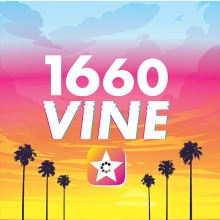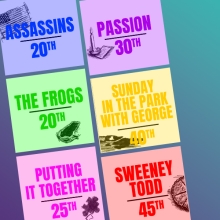
Full Synopsis
It is the morning of July 16, 1969, and Apollo 11 is blasting off on its soon-to-be historic trip to the moon. Jenny, a young woman, narrates from the crowd on the beach at Cape Kennedy. They all marvel at what is happening and the time and work that has gone into it. The scene cuts back to a day in 1957 – Jenny's grandmother just gave her a telescope as a present. She sits and stares through it in awe of what could be out there – what it must be like in space and beyond our tiny planet ("Opening / Up There")/ The news comes on; Hugh Reynolds is reporting from NBS Headquarters. Mankind's first satellite, Russia's Sputnik, is successfully in orbit. Russia has beaten America in the race to space, and the President cannot be happy. He assembles his advisers to figure out what to do. They all point the blame at each other, but, in the end, the President demands that he wants a satellite in space ASAP ("Countdown 1 / Seeink Red")!
News flash: 1961, Soviet Cosmonaut Yuri Gagaran is the first man in space. America is still behind in the race. In a lab, a doctor for NASA has Ham, a trained chimpanzee, who will be America's first astronaut. They are pretty confident, although there may still be some small problems. They figured it was smart not to risk a human life this early in the game, though ("America's First Astronaut"). The mission is successful, and Ham makes it to space and back safely. The program is then taken up a notch, and the chimp is replaced by veteran pilot, Colonel John Glenn. Jenny watches this all on the news as her father bothers her to do her homework. She is consumed with the big news, though – John Glenn is launching into space the very next day!
On February 20, 1962, John Glenn launches into orbit. There are a few complications with his re-entry, but he successfully returns to earth. John Glenn is an American hero now – he meets with the President, has a ticker tape parade in New York and has tons of fan mail, all wondering about what space is like ("Dear John Glenn"). The scene jumps to Neil Armstrong on the phone with his mother. He is reporting to her excitedly that he has been chosen as an astronaut and will be going to space.
A number of people stand in an unemployment line, reading about President Kennedy's promise to land a man on the moon by the end of the decade. He has said that it will take ten billion dollars to develop the space program. The unemployed wonder what they could do with ten billion dollars that would be more important than landing on the moon ("Ten Billion Dollars"). By 1965, the Gemini space flights have begun sending two astronauts at a time to practice many procedures that will be used on a moon mission. The struggle is tense now between Russia and America, but America is catching up in the race. In a doctor's office, Neil Armstrong is undergoing a number of extreme tests to see how he will handle various conditions in space. As Jenny – who is now Founder and President of The John F. Kennedy, Jr., High School Space Club – watches, Ed White takes the first ever space walk ("Floating"). Neil is about to launch into space for his mission where he and another astronaut will attempt to hook up to an unmanned spacecraft. This is a major step before landing on the moon. As he prepares for takeoff, two characters appear to him in his mind; they are his sense of Caution and Adventure. They go through the fears and excitement about the mission that he is taking. Neil and his partner go on the mission and have some success, but not without problems.
We now see three workers building the rocket. They dream of what their contributions will mean to the world and to America. They may not be the famous astronauts, but, without them, nothing would happen ("Maybe I'm Not Famous"). Jenny and her Dad eat frozen TV dinners as they watch a special on space travel. The astronauts talk about the food that they eat in space ("Space Food Waltz").
It is 1967 and three astronauts are aboard Apollo. There is a fire in the cockpit, and all three astronauts die. This is a major tragedy for America and a huge setback in the space program. The work continues, though, and the people keep dreaming of walking on the moon. The scene is now back where it began: a morning in 1969 as the world watches Apollo 11 launch on its now-famous journey to the moon.
Show History
Inspiration
Footprints on the Moon is a loose-book musical with book and lyrics by Art Perlman and music by Jeff Lunden. The musical is a series of scenes and songs based around many events of the "Space Race" of the 1950s and 1960s. They focus on such famous topics as sending animals into space, the legacy of Russian cosmonauts and the careers of legendary astronauts, Neil Armstrong and John Glenn.
The musical was written shortly after the tragedy of the 1986 Challenger explosion. As a result, Perlman and Lunden included the 1967 capsule fire that killed astronaut Ed White and two others to symbolize the terrible setbacks that were suffered to attain the Lunar Landing.
Productions
Footprints on the Moon was commissioned and produced by TheatreWorksUSA, a respected New York-based youth theatre company, in 1989 to commemorate the twentieth anniversary of the Moon Landing. The musical has been in the company's repertoire since, going on occasional tours every ten years or so.
Cultural Influence
- Footprints on the Moon was one of several TheatreWorks pieces to put the team of Art Perlman and Jeff Lunden on the scene. The two, who had been writing together since junior high school, would go on to craft the award-winning musical, Wings, along with receiving the Richard Rodgers Award from the Stephen Sondheim society in 2003.
Billing
- Book by
- Music by
- Lyrics by
Requirements
|
Book and Lyrics by
ARTHUR PERLMAN
|
Music by
JEFFREY LUNDEN
|
|
Video Warning
In accordance with the Performance License, you MUST include the following warning in all programs and in a pre-show announcement:ANY VIDEO AND/OR AUDIO RECORDING OF THIS PRODUCTION IS STRICTLY PROHIBITED.
Included Materials
| Item | Quantity Included |
|---|---|
| LIBRETTO/VOCAL BOOK | 10 |
| PERFORMANCE ACCOMPANIMENT CD (STD) | 1 |
Production Resources
| Resource |
|---|
| HOW DOES THE SHOW GO ON-10/CS |
| HOW DOES THE SHOW GO ON? |
| LOGO PACK |
| LOGO PACK DIGITAL |




